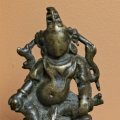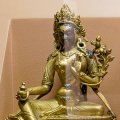Patan Museum (Nepal): photo 83
Photo 83 of 212 in Gallery: Patan Museum (Nepal)

Image title: Jambhala/Kubera (11th century)
Description of the photo
This Copper sculpture shows an image of Jambhala/Kubera, from the 11th/12th century origination from either Nepal or the Western Himalayas.—Materials used: Copper alloy, gilt.
Description: Jambhala/Kubera, the god of riches and productivity, can be identified by his jewel-spitting mongoose. The image holds the mongoose in one hand and a dub in the other. Jewels were once embedded in the depressions in his forehead and necklace.
Gallery information:
The Patan Museum is located on the Durbar square of Patan (Lalitpur/Lalitapura, Kathmandu, Nepal) which is associated Keshav Narayan Chowk (Keshavnarayan)—a form of Lord Vishnu. Being listed as a World Heritage Site, the whole of Durbar square is filled with exquisite temples, sculptures and other ancient structures, of which the ancient history history can be traced to the Malla Kings of Lalitpur. It is an important site for both Buddhism and Hinduism.
Photo details:
Date: 2019-12-02
Camera: SONY ILCE-6400
Exposure: 1/15
Aperture: f/4.5
ISO: 100
Focal length: 34mm
High resolution:
Download file
Size: 2.48 MB
Resolution: 1560 x 2804
© Photograph by Gabe Hiemstra.
License: CC BY-NC-ND 4.0

